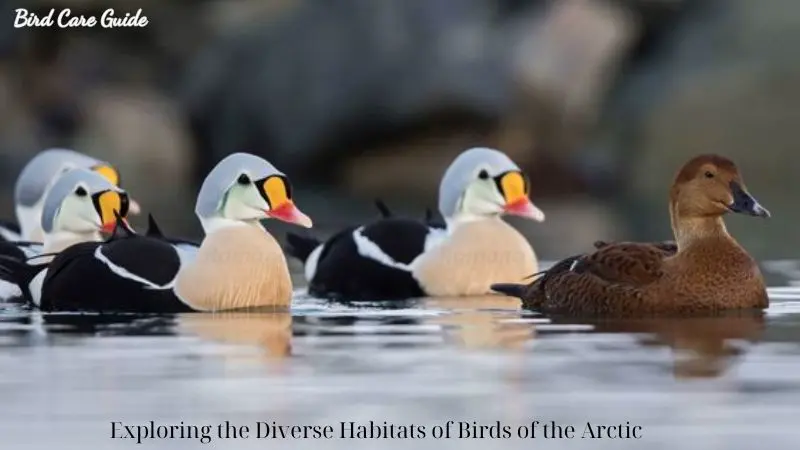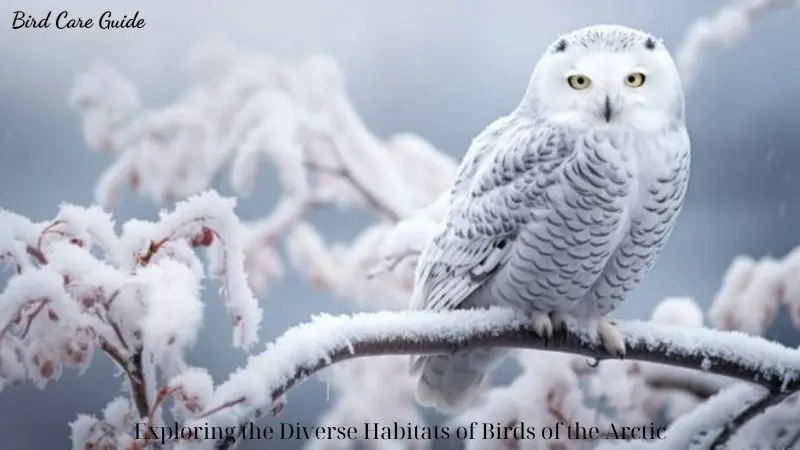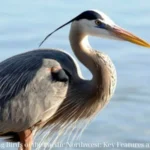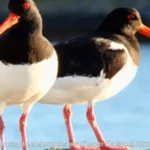The Arctic, a region characterized by extreme conditions and stark beauty, is home to a fascinating array of avian species. Birds of the Arctic have evolved to thrive in this harsh environment, exhibiting remarkable adaptations that allow them to survive and flourish. This article, “Bird Care Guide” will delves into the diverse habitats of these resilient birds, examining their unique characteristics, the challenges they face, and the remarkable ways they have adapted to one of the planet’s most unforgiving climates.
Tundra: The Open Plains of the Arctic
Characteristics of the Tundra
The tundra is one of the most distinctive habitats within the Arctic region. It is characterized by its flat, treeless landscape, covered with permafrost and dotted with small shrubs, mosses, and lichens. During the brief Arctic summer, the tundra comes alive with a burst of color as wildflowers bloom and insects emerge.
Avian Inhabitants of the Tundra
Many birds of the Arctic are well adapted to life on the tundra. Some of the most notable species include:
- Snowy Owl (Bubo scandiacus): One of the most iconic birds of the Arctic, the snowy owl is known for its striking white plumage, which provides excellent camouflage against the snowy landscape. These owls are formidable hunters, preying on small mammals such as lemmings.
- Lapland Longspur (Calcarius lapponicus): These small, sparrow-like birds are summer residents of the tundra, where they breed and raise their young. Their intricate songs and striking plumage make them a delight for birdwatchers.
- Arctic Tern (Sterna paradisaea): Renowned for its incredible migratory journey, the Arctic tern travels from the Arctic to the Antarctic and back each year. During the breeding season, they nest on the tundra, laying their eggs in shallow scrapes on the ground.
Adaptations to Tundra Life
Birds of the tundra have developed several adaptations to cope with the challenging conditions. These include:
- Camouflage: Many tundra birds have plumage that blends in with their surroundings, providing protection from predators.
- Nesting Strategies: Ground-nesting species, like the Lapland longspur, create nests in sheltered locations to protect their eggs and chicks from the elements and predators.
- Diet: Tundra birds often have varied diets, taking advantage of the seasonal abundance of insects, seeds, and small mammals.
Coastal Areas: Where Land Meets Sea

Characteristics of Coastal Habitats
The Arctic coastline is a dynamic environment where the land meets the sea. This habitat includes rocky shores, sandy beaches, and tidal flats. The rich marine life and intertidal zones provide ample food resources for many bird species.
Avian Inhabitants of Coastal Areas
Coastal areas support a diverse array of birds of the Arctic, including:
- Common Eider (Somateria mollissima): These large sea ducks are commonly found along Arctic coastlines. They are well known for their down feathers, which are used to line their nests and provide insulation for their eggs.
- Black-legged Kittiwake (Rissa tridactyla): These small gulls nest on cliff ledges along the coast, forming large colonies. They feed on fish and other marine organisms, often diving into the water to catch their prey.
- Red Phalarope (Phalaropus fulicarius): These unique shorebirds are known for their reversed sexual dimorphism, where females are more brightly colored than males. They forage by spinning in the water to create whirlpools that bring small invertebrates to the surface.
Adaptations to Coastal Life
Coastal birds of the Arctic have evolved several adaptations to thrive in their environment:
- Specialized Feeding Techniques: Birds like the red phalarope have developed unique foraging methods to exploit the rich food resources of coastal waters.
- Nesting Habits: Many coastal birds nest in colonies on cliffs or beaches, providing safety in numbers and reducing the risk of predation.
- Salt Tolerance: Some coastal species, such as the black-legged kittiwake, have specialized glands that allow them to excrete excess salt, enabling them to drink seawater.
Wetlands: The Arctic’s Vital Oases
Characteristics of Wetland Habitats
Arctic wetlands, including marshes, bogs, and fens, are crucial habitats that support a diverse range of flora and fauna. These areas are characterized by waterlogged soils, abundant vegetation, and a wealth of invertebrate life.
Avian Inhabitants of Wetlands
Wetlands are vital for many birds of the Arctic, particularly during the breeding season. Key species include:
- Northern Pintail (Anas acuta): These elegant ducks are common in Arctic wetlands, where they nest and raise their young. They have long, pointed tails and are skilled dabblers, feeding on aquatic plants and invertebrates.
- Red-throated Loon (Gavia stellata): Known for their distinctive red throats, these loons breed in Arctic wetlands. They build their nests close to water, and both parents share the responsibilities of incubating eggs and caring for chicks.
- Pectoral Sandpiper (Calidris melanotos): These shorebirds migrate to Arctic wetlands to breed. Males perform elaborate aerial displays to attract females, and their nests are well camouflaged in the dense vegetation.
Adaptations to Wetland Life
Wetland birds have developed several adaptations to make the most of their watery habitats:
- Breeding Synchronization: Many wetland birds time their breeding to coincide with the peak abundance of insects, ensuring a plentiful food supply for their chicks.
- Water-Repellent Feathers: Birds like the northern pintail have specialized feathers that repel water, keeping them dry and buoyant while foraging.
- Elaborate Courtship Displays: Species such as the pectoral sandpiper use intricate displays to attract mates, ensuring successful reproduction in the short Arctic summer.
Forested Areas: The Boreal Edge
Characteristics of Forested Habitats
While the Arctic is often associated with treeless landscapes, its southern boundary merges with the boreal forest, creating a transitional zone known as the forest-tundra ecotone. This area features sparse tree cover, primarily composed of hardy species like spruce and birch.
Avian Inhabitants of Forested Areas
The forested regions of the Arctic provide important habitat for several bird species, including:
- Boreal Chickadee (Poecile hudsonicus): These small, hardy birds are year-round residents of the boreal forest. They have a distinctive brown cap and are known for their cheerful calls and acrobatic foraging behavior.
- Gray Jay (Perisoreus canadensis): Also known as the Canada jay, this bird is a familiar sight in the boreal forest. It is known for its intelligence and resourcefulness, often storing food to survive the harsh winter months.
- Spruce Grouse (Falcipennis canadensis): These birds are well adapted to life in the boreal forest. They feed primarily on conifer needles during the winter and are known for their cryptic plumage, which helps them blend into their surroundings.
Adaptations to Forest Life
Birds of the forest-tundra ecotone have developed several adaptations to thrive in their unique habitat:
- Food Caching: Species like the gray jay store food in hidden caches, ensuring a steady food supply throughout the winter.
- Specialized Diets: Birds such as the spruce grouse have digestive systems adapted to process the tough, resinous needles of conifer trees.
- Insulating Plumage: Many forest birds have dense, insulating feathers that help them retain heat during the cold Arctic winter.
Conservation Challenges and Efforts
Threats to Birds of the Arctic
Despite their remarkable adaptations, birds of the Arctic face numerous threats, primarily driven by human activities and climate change:
- Climate Change: The Arctic is warming at an unprecedented rate, leading to habitat loss, changes in food availability, and increased competition from temperate species moving northward.
- Habitat Destruction: Industrial activities, such as oil and gas exploration, mining, and infrastructure development, can destroy critical habitats and disrupt breeding sites.
- Pollution: Contaminants such as heavy metals and persistent organic pollutants accumulate in the Arctic food web, posing a significant risk to bird populations.
Conservation Efforts
Efforts to protect birds of the Arctic are crucial for their survival. Key strategies include:
- Protected Areas: Establishing and maintaining protected areas helps safeguard critical habitats from development and industrial activities.
- Climate Action: Reducing greenhouse gas emissions and mitigating the impacts of climate change are essential to preserving the Arctic ecosystem.
- Research and Monitoring: Ongoing research and monitoring provide valuable data on bird populations, migration patterns, and habitat use, informing conservation strategies.
- Community Engagement: Involving local and Indigenous communities in conservation efforts ensures that traditional knowledge and sustainable practices are integrated into management plans.
Challenges Faced by Birds of the Arctic
Climate Change
Climate change is one of the most significant threats to the birds of the Arctic. Rising temperatures are causing shifts in habitat ranges, altering food availability, and leading to changes in migration patterns. Melting sea ice, in particular, poses a significant challenge for species that rely on ice-covered seas for breeding and foraging.
Habitat Loss
Habitat loss due to human activities such as oil and gas exploration, mining, and infrastructure development is another major concern. These activities can lead to the destruction or degradation of critical breeding and feeding areas, making it harder for Arctic bird populations to thrive.
Pollution
Pollution, including oil spills and plastic waste, poses a serious threat to the birds of the Arctic. Oil spills can contaminate the feathers of seabirds, reducing their insulation and buoyancy, while plastic waste can be ingested, leading to injury or death.
Conservation Efforts
Protected Areas
Establishing protected areas is crucial for the conservation of Arctic bird species. These areas provide safe havens where birds can breed, feed, and migrate without the pressures of human activities. International cooperation is essential to ensure these protected areas are managed effectively.
Monitoring and Research
Ongoing monitoring and research are vital to understanding the impacts of environmental changes on Arctic bird populations. Citizen science programs and collaborations between governments, NGOs, and research institutions play a key role in gathering data and developing conservation strategies.
Mitigating Climate Change
Addressing climate change through global efforts to reduce greenhouse gas emissions is critical for the long-term survival of Arctic bird species. Protecting the Arctic ecosystem requires concerted action at local, national, and international levels to mitigate the effects of climate change and preserve this unique environment.
Conclusion
The diverse habitats of the Arctic support a remarkable array of bird species, each uniquely adapted to thrive in this extreme environment. From the open plains of the tundra to the dynamic coastal areas, the vital wetlands, and the boreal edge, birds of the Arctic exhibit incredible resilience and adaptability. Understanding and protecting these habitats is crucial for ensuring the survival of these fascinating birds in the face of growing environmental challenges. By appreciating the beauty and complexity of Arctic avian life, we can better advocate for their conservation and the preservation of one of the world’s most extraordinary regions.





